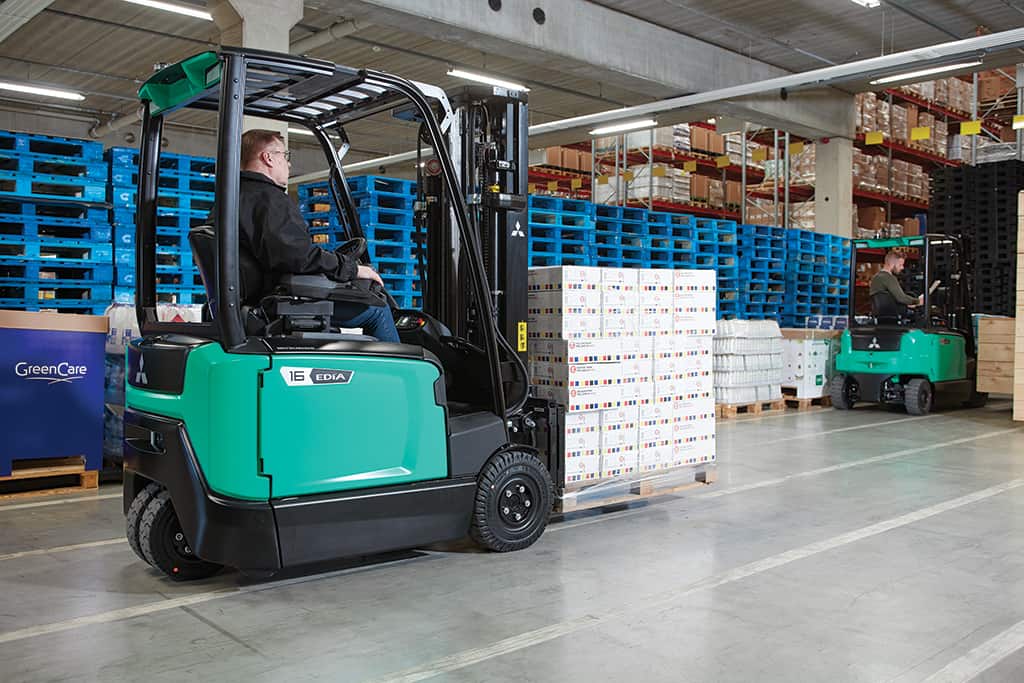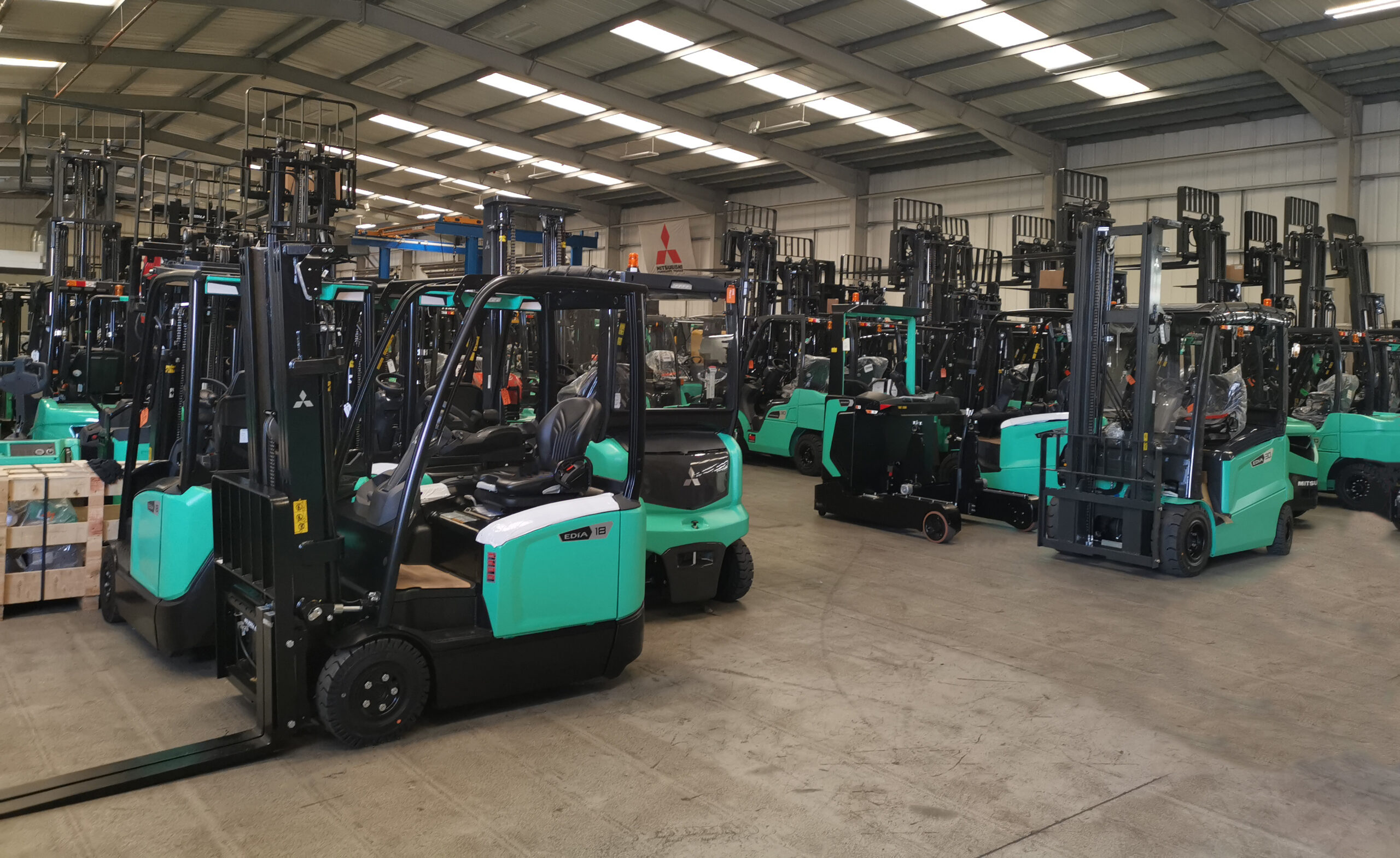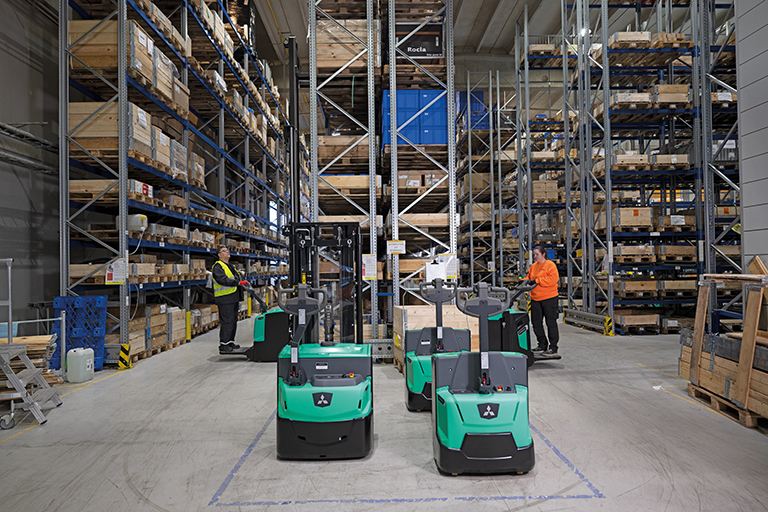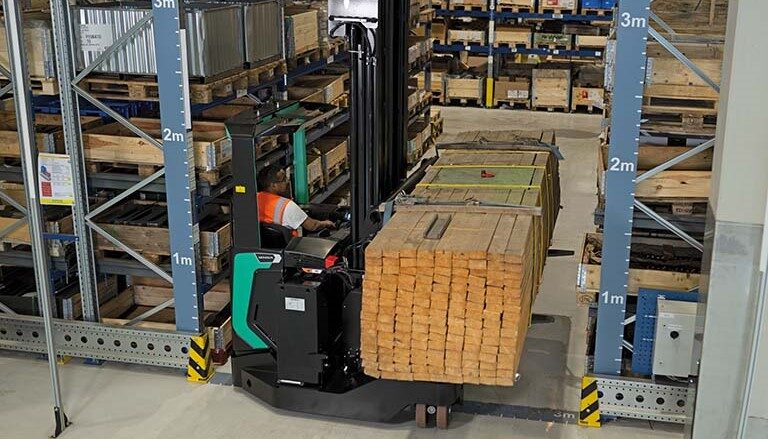What is a Counterbalance Forklift? – Your Complete Guide
Counterbalance forklifts are indispensable tools for moving heavy loads in various settings, from warehouses and factories to distribution centres. Their unique design, featuring weight distribution towards the rear, enables them to counterbalance the weight of the loads they carry effortlessly.
This clever engineering allows these forklifts to operate in a wide range of tight spaces and tackle indoor and outdoor tasks precisely. Equipped with robust engines or electrical motors and precise steering mechanisms, they deliver exceptional stability and manoeuvrability.
Whether it’s the efficient loading and unloading of pallets, seamless inventory movement, or the handling of construction materials, counterbalance forklift trucks are pivotal in boosting productivity and ensuring the smooth, safe flow of goods across industries.
What is a counterbalance forklift?
A counterbalance forklift truck is an industrial vehicle designed to lift and transport materials over short distances. It is uniquely built with a heavy counterweight at its rear, which serves to offset the weight of the load it carries at the front. This smart design eliminates the need for extra stabilising arms or legs, allowing the vehicle to approach loads directly.
With its forks extending from the front without any reach mechanism or protruding supports, the forklift relies on its own weight combined with the additional counterweight to remain stable. Its versatile design makes it popular in various industrial environments, from warehouses to distribution centres.
Types of counterbalance forklifts
Counterbalance trucks are versatile machines with different types to cater to various applications and requirements. Some common types include:
- Electric counterbalance forklifts
- Diesel counterbalance forklifts
- Gas counterbalance forklifts
- Three-wheel counterbalance forklifts
- Four-wheel counterbalance forklifts
- Compact counterbalance forklifts
What is a counterbalance forklift used for?
A counterbalance truck facilitates the lifting and moving of materials in places like warehouses and dockyards. With a rear counterweight for stability, it deftly handles loads without requiring external stabilisers. Its efficiency shines in tasks such as stacking, unloading, and shifting goods over limited distances.
How does a counterbalance forklift work?
Lifting mechanism
The lifting process in a counterbalance forklift hinges on its hydraulic system. Using levers, the operator channels hydraulic fluid into the device’s cylinders, pushing pistons that elevate the mast and forks. The rear counterweight maintains the machine’s equilibrium, ensuring safe lifting.
Role of counterbalance weights
Located at the rear, counterbalance weights play a pivotal role in stabilising lifting machinery. They prevent tipping, increasing safety during operations by counteracting the load’s weight. This balance ensures forklifts and similar devices can securely manage loads without extra support.
Safety features
Counterbalance forklifts prioritise safety with features like rear counterweights, ensuring stability, and emergency brakes for sudden stops. Overload alarms alert against excessive weights, while backup beepers signal movement. Anti-slip platforms and mast tilt functions further enhance operational safety, safeguarding operators and those nearby.
Benefits of using a counterbalance forklift
Versatility
The versatility of a counterbalance truck is a standout benefit. With no obstructing stabilising arms, they smoothly handle tasks in different settings, from compact warehouse spaces to expansive dockyards. This adaptability makes them a valuable asset in various industrial environments.
Ease of operation
Counterbalance forklift trucks are designed for user-friendly operation. Their intuitive controls, combined with a design free from external stabilisers, streamline load handling. This expedites operator training and boosts efficiency and productivity in diverse industrial settings.
Efficiency in space utilisation
Efficient space utilisation is a hallmark of a counterbalanced truck. Their sleek design, lacking protruding stabilisers, lets them easily navigate confined areas. This ensures optimal warehouse storage configurations, minimising unnecessary movements and maximising space, leading to streamlined operations.
Considerations before choosing a counterbalance forklift
Load capacity
Load capacity is pivotal when choosing a counterbalance forklift. Aligning the forklift’s weight limit with expected loads ensures safety and smooth operations. A suitable capacity choice avoids the risks of overloading and extends the equipment’s durability, fostering efficient material handling.
Lift height
Lift height is a key factor in choosing a counterbalance forklift. It indicates the maximum elevation loads can be achieved safely. Aligning this with storage heights optimises vertical space use and ensures smooth operations, reducing risks associated with overreaching or mishandling.
Fuel type
When selecting a counterbalance forklift, the fuel type matters. Options like electric, diesel, or gas influence costs, eco-friendliness, and suitability for indoor or outdoor tasks. Choosing a fuel type that best fits the work setting, budget, and environmental considerations is essential.
Counterbalance forklift vs. other forklift types
Reach forklift trucks
Reach forklifts are tailored for tight warehouse aisles. With an extendable mast, they access high shelves with ease. Their streamlined design optimises space, making them indispensable for vertical storage scenarios.
Side loaders
Side loaders are forklifts tailored for handling lengthy materials like timber or pipes. Carrying loads sideways, they adeptly navigate tight aisles. With the operator positioned sideways, visibility is enhanced, ensuring efficient and safe transportation in constrained spaces.
Pallet trucks
Pallet trucks, often known as pump trucks or jacks, are manual or powered devices designed to lift and transport pallets. With their forked design, they slide easily under pallets, allowing for quick lifting and moving. They’re especially suited for warehouses, aiding in the swift handling of goods on pallets.
Frequently Asked Questions (FAQs)
Where are counterbalance forklifts commonly used?
They are versatile and used in various settings like smooth surfaces and open spaces, from warehouses and manufacturing plants to dockyards and construction sites.
What types of fuel can power a counterbalance forklift?
They can be powered by electricity (batteries), diesel, or gas (LPG/CNG).
What’s the typical lift capacity for these forklifts?
Load capacity varies by model and design, ranging from as little as 1,000 pounds (around 450 kg) to heavier loads of more than 35,000 pounds (around 16,000 kg) for larger industrial models.
How high can counterbalance forklifts lift?
Lift heights vary, but many standard models can lift loads up to around 20 feet (6 metres). Specialised models might offer more extended reach.
Are there specific safety protocols to follow when operating a counterbalance forklift?
Yes, operators should be trained and certified, adhere to load limits, use safety belts, have a counterbalance forklift licence, go through counterbalance forklift truck training and follow guidelines for safe manoeuvring, especially in populated areas.









